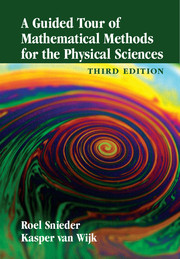Book contents
- Frontmatter
- Contents
- List of figures
- List of tables
- About the authors
- 1 Introduction
- 2 Dimensional analysis
- 3 Power series
- 4 Spherical and cylindrical coordinates
- 5 Gradient
- 6 Divergence of a vector field
- 7 Curl of a vector field
- 8 Theorem of Gauss
- 9 Theorem of Stokes
- 10 The Laplacian
- 11 Scale analysis
- 12 Linear algebra
- 13 Dirac delta function
- 14 Fourier analysis
- 15 Analytic functions
- 16 Complex integration
- 17 Green's functions: principles
- 18 Green's functions: examples
- 19 Normal modes
- 20 Potential field theory
- 21 Probability and statistics
- 22 Inverse problems
- 23 Perturbation theory
- 24 Asymptotic evaluation of integrals
- 25 Conservation laws
- 26 Cartesian tensors
- 27 Variational calculus
- 28 Epilogue, on power and knowledge
- References
- Index
8 - Theorem of Gauss
Published online by Cambridge University Press: 05 March 2015
- Frontmatter
- Contents
- List of figures
- List of tables
- About the authors
- 1 Introduction
- 2 Dimensional analysis
- 3 Power series
- 4 Spherical and cylindrical coordinates
- 5 Gradient
- 6 Divergence of a vector field
- 7 Curl of a vector field
- 8 Theorem of Gauss
- 9 Theorem of Stokes
- 10 The Laplacian
- 11 Scale analysis
- 12 Linear algebra
- 13 Dirac delta function
- 14 Fourier analysis
- 15 Analytic functions
- 16 Complex integration
- 17 Green's functions: principles
- 18 Green's functions: examples
- 19 Normal modes
- 20 Potential field theory
- 21 Probability and statistics
- 22 Inverse problems
- 23 Perturbation theory
- 24 Asymptotic evaluation of integrals
- 25 Conservation laws
- 26 Cartesian tensors
- 27 Variational calculus
- 28 Epilogue, on power and knowledge
- References
- Index
Summary
In Section 6.7 we determined that the divergence of the gravitational field in free space vanishes: (∇ · g) = 0. This was sufficient to determine the gravitational field in N dimensions as expression (6.49). However, that expression is not quite satisfactory, because it contains an unknown constant A. In fact, at this point we have no idea how this constant is related to the mass M that causes the gravitational field! The reason for this is simple: to derive the gravitational field in (6.49) we have only used the field equation (6.45) for free space (where ρ = 0). However, if we want to find the relation between the mass and the resulting gravitational field, we must also use the field equation (∇ · g) = −4πGρ at places where mass is present. More specifically, we have to integrate the field equation in order to find the total effect of the mass. The theorem of Gauss gives us an expression for the volume integral of the divergence of a vector field.
8.1 Statement of Gauss’ theorem
Section 6.2 introduced the divergence as the flux per unit volume. In fact, expression (6.8) gives us the outward flux dΦv through an infinitesimal volume dV: dΦv = (∇ · v)dV. We can integrate this expression to find the total flux through the surface S, which encloses the total volume V:
∲Sv · dS = ∫V(∇ · v) dV (in three dimensions)
In deriving this, equation (6.8) has been used to express the total flux on the left-hand side. This expression is called the theorem of Gauss, or the divergence theorem.
We did not use the dimensionality of the space to derive (8.1); the relation holds in any number of dimensions. You may recognize the one-dimensional version of (8.1). In one dimension the vector v has only one component vx; hence, (∇ · v) = δxvx.
- Type
- Chapter
- Information
- Publisher: Cambridge University PressPrint publication year: 2015



